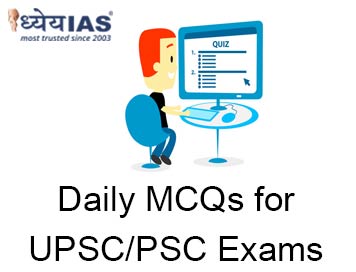Home > Daily-mcqs
Daily-mcqs 29 Jul 2025

Q1:
1. It aims to make India a global hub for the production, utilization, and export of green hydrogen and its derivatives. 2. The total outlay of the mission is ₹19,744 crore, of which ₹600 crore is allocated for FY 2024–25. 3. The mission targets a green hydrogen production capacity of 10 million metric tonnes per annum by 2030. Which of the statements given above is/are correct?
With reference to the National Green Hydrogen Mission (NGHM), consider the following statements:
A: 1 and 2 only
B: 2 and 3 only
C: 1 and 3 only
D: 1, 2 and 3
Answer: A
Explanation:
· Statement 1 is correct: The main goal is to make India a global hub for green hydrogen production, utilization, and export.
· Statement 2 is correct: The total outlay is ₹19,744 crore, and ₹600 crore has been earmarked for FY 2024–25.
· Statement 3 is incorrect: The target is 5 million metric tonnes (MMT) per annum by 2030, not 10 MMT.
Q2:
With reference to Sohrai Art, recently seen in the news, consider the following statements: 1. It is primarily practised by tribal men in central and western India. 2. The word 'Sohrai' is linked to cattle herding. 3. Sohrai paintings have historical connections to prehistoric rock art in Jharkhand. Which of the statements given above is/are correct?
A: 1 and 2 only
B: 2 and 3 only
C: 1 and 3 only
D: 1, 2, and 3
Answer: B
Explanation:
Statement 1 Incorrect
Statement 2 Correct
Statement 3 Correct
Q3:
With reference to the traditional Paithani sarees of India, consider the following statements: 1. Paithani sarees are woven using pure silk and real zari threads, and the weaving process is entirely manual. 2. These sarees originated in Paithan, an ancient town on the banks of the Krishna River in Maharashtra. 3. The distinctive shot (dual-tone) effect in Paithani sarees is achieved using silk threads of two different colours. How many of the statements given above are correct?
A: Only 1
B: Only 2
C: Only 3
D: None
Answer: B
Explanation:
Statement 1 Correct
Statement 2 Incorrect
Statement 3 Correct
Q4:
With reference to Glacial Lake Outburst Floods (GLOFs), consider the following statements: 1. Moraine-dammed lakes are considered the most vulnerable to GLOFs. 2. GLOFs generally develop over days and can be predicted through early signs of glacial surging. 3. Earthquakes can trigger GLOFs by destabilizing natural dams. Which of the statements given above is/are correct?
A: 1 only
B: 1 and 3 only
C: 2 and 3 only
D: 1, 2 and 3
Answer: B
Explanation:
Q5:
Assertion (A): Indian Railways is developing hydrogen-powered trains to reduce dependence on diesel fuel. Which one of the following is correct?
Reason (R): Hydrogen fuel cells emit nitrogen oxides (NOx) and carbon dioxide (CO₂) during combustion.
A: Both A and R are true, and R is the correct explanation of A
B: Both A and R are true, but R is not the correct explanation of A
C: A is true, but R is false
D: A is false, but R is true
Answer: C
Explanation:
· Assertion is true: Indian Railways aims to reduce diesel dependence through hydrogen-powered trains, contributing to energy security and decarbonization.
· Reason is false: Hydrogen fuel cells emit only water vapor, not NOx or CO₂, making them a clean energy alternative.